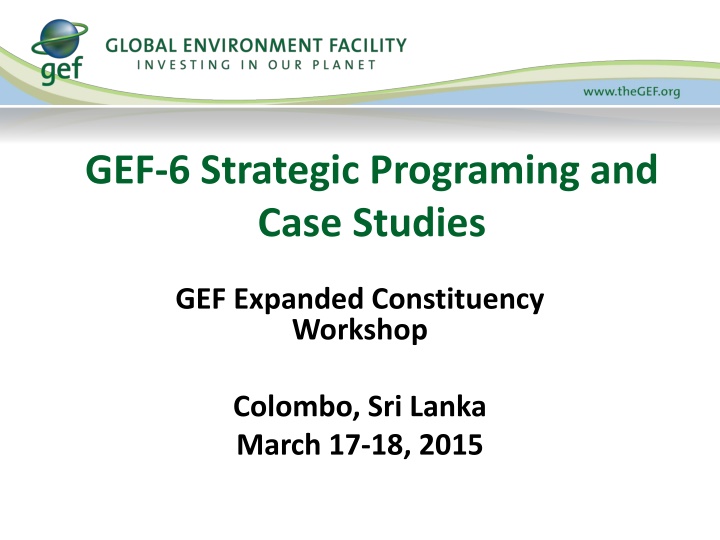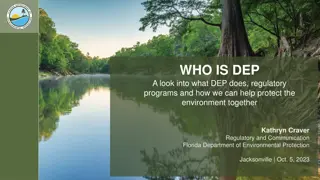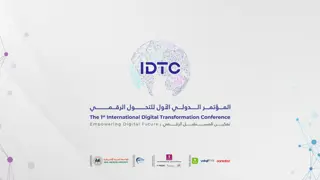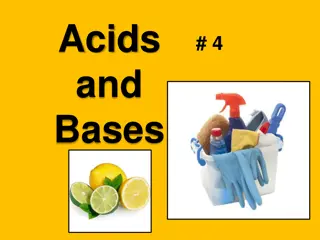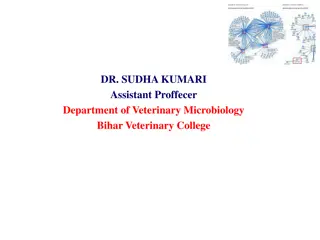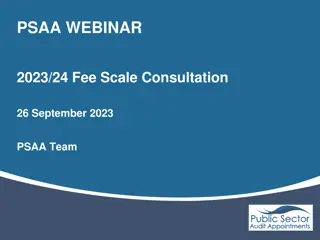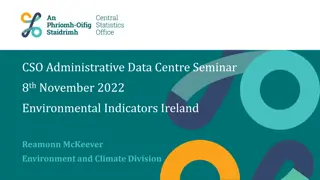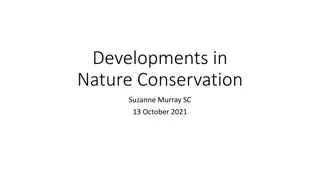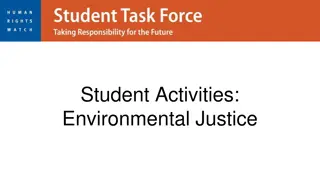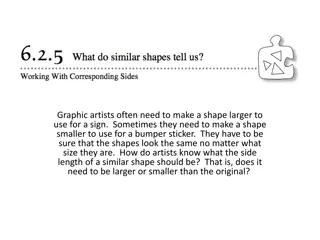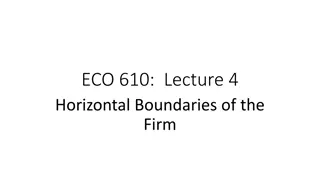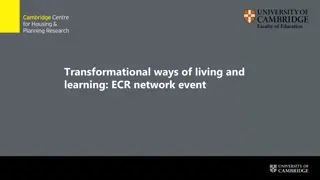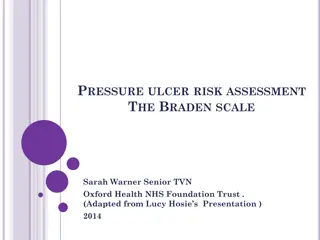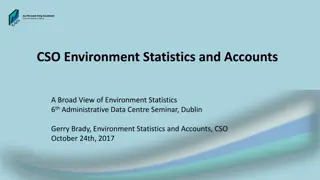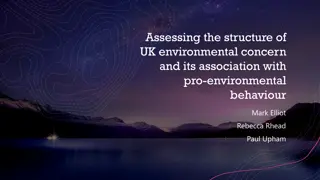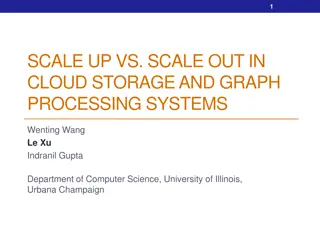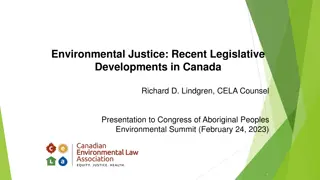Strategies for Environmental Transformation and Impact at Scale
Explore strategic programing, integrated thinking, and case studies from the GEF-6 workshop in Colombo, Sri Lanka, focusing on drivers of environmental degradation, sustainability solutions, and partnerships for transformative change. Discover key themes such as food security, sustainable cities, forests, and climate resilience, emphasizing the importance of integrated approaches to address complex environmental challenges.
Download Presentation

Please find below an Image/Link to download the presentation.
The content on the website is provided AS IS for your information and personal use only. It may not be sold, licensed, or shared on other websites without obtaining consent from the author.If you encounter any issues during the download, it is possible that the publisher has removed the file from their server.
You are allowed to download the files provided on this website for personal or commercial use, subject to the condition that they are used lawfully. All files are the property of their respective owners.
The content on the website is provided AS IS for your information and personal use only. It may not be sold, licensed, or shared on other websites without obtaining consent from the author.
E N D
Presentation Transcript
GEF-6 Strategic Programing and Case Studies GEF Expanded Constituency Workshop Colombo, Sri Lanka March 17-18, 2015
Blending Integrated Thinking with Focal / Multifocal Area Strategy Delivery Selected SD Themes Food Security Sustainable Cities Forests Integrated Approach Pilots Partnership for SS-Africa Cities Commodities Climate Change International Management Degradation Biodiversity Focal / Multi-focal Area Strategy Delivery Sustainable Chemicals Forest Waters Land
GEF2020 Strategy A new strategy of the GEF to support transformational change and achieve impacts at scale. Outline of GEF2020 Strategy Focus on drivers of environmental degradation Deliver integrated solutions, given that many global challenges are interlinked Forge close relationships with a variety of stakeholders Finance resilience and adaptation Ensure complementarity and synergies in climate finance
Integrated Thinking Drivers of environmental degradation are linked in complex ways Single issue analysis leads to silo thinking Systems analysis leads to integrated thinking Integrated thinking inspires creative and inclusive solutions Creative and inclusive solutions deliver environmental benefits aligned with GEF focal area objectives Examples: Water, Food & Energy Nexus; Urban Environments; Integrated Approach Pilots
Cost of Power & Fuel Availability of Food Cost of Water Human Health Biodiversity impacts Food prices Natural Disasters Water, Food, Energy Nexus Availability, distribution, access and sustainability of Water Food, energy and their resilience in the face of climate change. 9. Managing the Human- interface: landscape/seascape approach Objective 1: Promote innovation & technology transfer SFM 1: To maintain forest resources 4.Water/Food/Energy/ Ecosystem Security Nexus LD 3: Integrated Landscapes
Pollution and Climate Change Waste & Water Bio-diversity Buildings Industry & Jobs Transport Land-Use Planning Urban Environments Urban environments are complex systems that touch our lives and the environment across all focal areas. Use integrated thinking for creative solutions. Program 3: Integrated low- carbon urban systems 5. Mainstreaming SLM in Development 6. Prevent the Loss and Degradation of Coastal Habitat Climate resilient urban systems
Focal Area Objectives Using integrated thinking, propose creative and inclusive solutions Solutions should deliver results that align with GEF-6 focal area objectives Single FA projects might still be necessary in specific contexts MFA projects on the rise FA MFA FA FA
GEF-6 BD Strategy Goal: To maintain globally significant biodiversity and the ecosystem goods and services that it provides to society BD 2: Reduce threats to Globally Significant Biodiversity BD1: Improve Sustainability of Protected Area System BD4: Mainstreaming Biodiversity Conservation and Sustainable Use in Production Landscapes/ Seascapes and Sectors BD 3: Sustainable Use of Biodiversity 6. Ridge to Reef: Maintaining integrity and function of globally significant coral reefs 3. Preventing extinction of known threatened species 9. Managing the Human- interface: landscape/seascape approach 1. Improving financial sustainability and effective management of national ecological infrastructure 7. Securing Agriculture s Future: Sustainable use of plants and animals genetic resources. 4. Prevention, control, and mgmt of Invasive Alien Species. 10. Integration of biodiversity and ecosystem services in development and financial planning 2 . Expanding the reach of the global protected area estate. 8. Implementing the Nagoya Protocol on Access and Benefit Sharing. 5. Implementing the Cartagena Protocol of Biosafety
GEF-6 CCM Strategy Goal: To support developing countries to make transformational shifts towards low emission, resilient development path Objective 3: Foster enabling conditions to mainstream mitigation concerns into SD strategies Objective 1: Promote innovation & technology transfer Objective 2: Demonstrate systemic impacts of mitigation options 5. Convention obligations for planning and mitigation contributions 1. Low carbon technologies and mitigation options 3. Integrated low-carbon, urban systems 2 . Innovative policy packages and market initiatives 4. Forests and other land use, and climate smart agriculture
GEF-6 LD Strategy Goal: To arrest or reverse land degradation (desertification and deforestation) LD 1: Agriculture and Rangeland Systems LD 2: Forest Landscapes LD 3: Integrated Landscapes LD 4: Institutional and Policy Frameworks 3. Landscape Management and Restoration community and livelihood-based options for increasing forest and tree cover 1. Agro-ecological Intensification efficient use of natural capital (land, soil, water, and vegetation) in crop and livestock production systems 5. Mainstreaming SLM in Development influencing institutions, policies, and governance frameworks for SLM 4. Scaling-up SLM moving appropriate interventions to scale for crop and rangeland productivity 2. SLM in Climate-Smart Agriculture innovative practices for increasing vegetative cover and soil organic carbon
Sustainable Forest Management GEF-6 Strategy Goal: To achieve multiple environmental, social and economic benefits from improved management of all types of forests and trees outside of forests. SFM 2: To enhance forest management SFM 3: To restore forest ecosystems SFM 4: To increase regional and global cooperation SFM 1: To maintain forest resources Integrated land use planning Identification and monitoring of HCVF Identifying and monitoring forest loss Developing and implementing model projects for PES Capacity development for SFM within local communities Supporting sustainable finance mechanisms for SFM Building of technical and institutional capacities to identify degraded forest landscapes and monitor forest restoration Integrating plantation management in landscape restoration Private sector engagement Global technologies for national progress
GEF-6 IW Strategy Goal: To promote collective management of transboundary water systems and implementation of the full range of policy, legal and institutional reforms and investments contributing to sustainable use and maintenance of ecosystem services Objective 2: Balance Competing Water-uses in the Management of Transboundary Surface and Groundwater Objective 3: Rebuild Marine Fisheries, Restore and Protect Coastal Habitats, and Reduce Pollution of Coasts and LMEs Objective 1: Catalyze Sustainable Management of Transboundary Waters 1. Foster Cooperation for Sustainable use of Trans- boundary Water Systems & Economic Growth 3. Advance Conjunctive Management of Surface & Groundwater systems 5. Reduce Ocean Hypoxia 6. Prevent the Loss and Degradation of Coastal Habitat 2 .Increase Resilience & Flow of Ecosystems Services in Context of Melting High Altitude Glaciers 4. Water/Food/Energy/ Ecosystem Security Nexus 7. Foster Sustainable Fisheries
GEF-6 C&W Strategy Goal: to prevent the exposure of human and the environment to harmful C&W of global importance, including POPs, mercury and ODS, through a significant reduction in the production, use, consumption and emissions/releases of those chemicals and waste Objective 1: Develop the enabling conditions, tools and environment for the sound management of harmful chemicals and wastes Objective 2: Reduce the prevalence of harmful chemicals and waste and support the implementation of clean alternative technologies/substances 3. Reduction and elimination of POPs 1. Develop and demonstrate new tools and economic approaches for managing harmful chemicals and waste in a sound manner 4. Reduction or elimination of anthropogenic emissions and releases of mercury to the environment 5. Complete the phase out of ODS in CEITs and assist Article 5 countries under the Montreal Protocol to achieve climate mitigation benefits 2. Support enabling activities and promote their integration into national budgets and planning processes, national and sector policies and actions and global monitoring 6. Support regional approaches to eliminate and reduce harmful chemicals and waste in LDCs and SIDs
GEF-6: Adaptation Programming Strategy Aims to increase resilience to the adverse impacts of climate change in vulnerable developing countries, through both near- and long-term adaptation measures in affected sectors, areas and communities Thematic Priorities for Adaptation Agriculture and food security Water resources management Coastal zone management Infrastructure Disaster risk management Natural resources management Health Climate information services Climate-resilient urban systems Small Island Developing States
